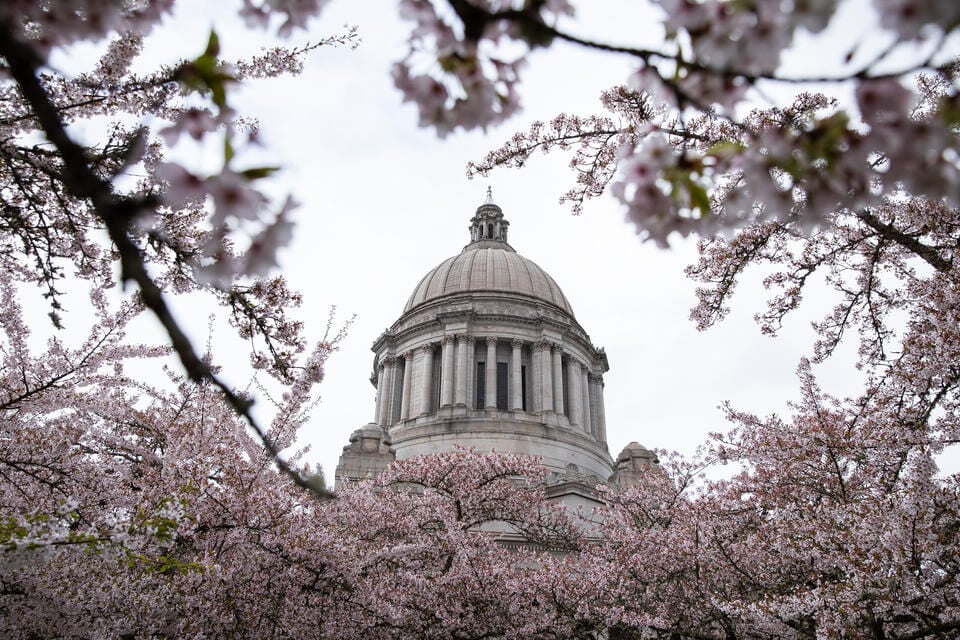A financial Sword of Damocles still hangs over Washington’s budget as uncertainty remains over a federal funding freeze.
The state might have to trim additional billions of dollars from the Washington Legislature’s upcoming 2025-27 budget – already facing a $12 billion shortfall – if President Donald Trump follows through on his order to halt all federal grants and loans to the states. No one knows how much will be trimmed.
While Trump’s administration rescinded a memo about the executive order after federal agencies and state governments were confused by the document’s vague wording, the original executive order was left in place, meaning much of the federal funding to states is still in limbo.And while several judges have stalled the implementation of the funding freeze, several Trump senior officials have criticized judges and at least one judge has said that the administration has ignored orders to release the funds.Washington’s leaders are chewing their fingernails under that dangling sword, and held a Thursday press conference in Olympia to voice their concerns.“Unfortunately, President Trump shows little inclination to work with the states that don’t support his views,” said Gov. Bob Ferguson on Thursday. “We’re dealing with chaos coming down from Washington, D.C. We will still preserve our values. … My message to President Trump is we will work with you on common issues, but you are making it tough.” Washington Attorney General Nick Brown added: “We have an all-out attack on the rule of law. … We cannot let that stand.”Washington is part of five multistate lawsuits against executive orders issued by Trump. Those lawsuits contest Trump’s orders to freeze federal money going to the states; remove birthright citizenship for immigrant children born in the United States; freeze health research funds; and ban gender-affirming health care for transgender youths younger than 19. On Thursday, Washington joined 13 other states in filing a federal lawsuit in New Mexico, alleging that Elon Musk’s massive government cutting is unconstitutional without congressional approval. An uncertain future The Washington Post reported that at least 10 judges stopped Trump administration moves in the first three weeks of his second term, including several who blocked the funding freeze. But the administration has criticized the courts. On Sunday, Vice President J.D. Vance posted on the social network X (formerly Twitter): “Judges aren’t allowed to control the executive’s legitimate power.” “The amount of ignorance that came from a tweet like that is astounding,” Brown said on Thursday.Ferguson said ignoring court rulings would send the nation into an unprecedented constitutional crisis, with no one having a grasp on how to combat it. He described ignoring federal court orders as “an absolute red line underscored several times.”The other fear nagging Ferguson and other leaders that Trump has a pattern of retaliating against those who oppose or criticize him. Washington state politics has been dominated by Democrats in the past eight years.Ferguson does not have a definitive answer on what to do if Trump retaliates against Washington for opposing the president. “I’m not underestimating [nor] am blind to the impact of these decisions,” he said. “A core issue is preserving Washington’s values, to preserve our civil rights and freedoms,” he said, citing Washington’s opposition to Trump’s failed Muslim immigration ban in the president’s first term.Another wrinkle in determining how changes in federal funding will affect the state budget is that this legal and political picture changes on a daily basis, depending on court rulings and the Trump administration’s counter-moves.For example, this past week, $156 million in federal money going to provide solar energy for individual Washington homes and buildings has been frozen, then unfrozen and then frozen again, said Joe Nguyen, director of the state’s commerce department. Washington’s legislative budget crunchers don’t know if billions of dollars will be yanked from them either before or after they map out how to raise and spend money from July 1, 2025 through June 30, 2027. Right now, legislative leaders acknowledge that they have no control over federal appropriations and appear to have adopted a wait-and-see attitude.Washington House Majority Leader Joe Fitzgibbon, D-West Seattle, said at a press availability earlier this week that too many variables exist on what the Trump administration might do with funding to the states. “It’s impossible to plan for,” he said.“You can’t be awake in America and not be worried because we have a lawless federal administration that is rolling over a compliant Congress,” said Senate Majority Leader Jamie Pedersen, D-Seattle. “One of the richest men in the world is going after the poorest,” said Senate Deputy Majority Leader Manka Dhingra, D-Redmond. On the Republican side, Senate Minority Leader John Braun of Centralia echoed that the situation is too hazy, but said the situation was not as chaotic as some might perceive it. “I’m not sure anything will happen fast enough to affect our budget,” Braun said. “They have complied with every judge’s order. … I don’t think it is the wild lawlessness that [is] sometimes being reported,” Braun said.“I fully expect the Trump administration to follow the law,” said House Deputy Minority Leader Chris Corry, R-Yakima. Braun and Corry both expect Congress to step into this funding issue.Washington is one of 22 states that took part in a federal lawsuit in U.S. District Court in Rhode Island to permanently stop the freeze. The lawsuit declares Trump’s freeze by executive order is unconstitutional in that he is interfering with Congress’ power to appropriate money. The original executive order paused federal loans and grants programs to review the programs for compliance with the administration’s goals and priorities. Two weeks ago, Trump issued, then rescinded, a memo that would have implemented that executive order. The memo was walked back after federal agencies and state governments reported being confused by the document’s vague wording. The order did not apply to programs that provided direct assistance to individuals, such as Medicaid, Medicare, Social Security and the Supplemental Nutrition Assistance Program (SNAP), though state portals for Medicaid went offline after the memo was issued.On Monday, U.S. District Judge John McConnell in Rhode Island said the Trump administration has violated his order to stop the funding freeze after the 22 states complained some of the frozen appropriations have not been restored.Potential impactIf the Trump administration succeeds with its effort to freeze federal spending on grants and loans, it would have a devastating effect on Washington to the tune of billions of dollars, according to the Washington’s Office of Financial Management. The OFM does not have estimates on federal appropriations to Washington for fiscal 2026, which begins July 1, 2025. However, Washington received $27 billion in federal money in fiscal 2024, the latest year for which federal figures are available. That was 32% of the fiscal 2024 state budget. These figures do not include federal money going to Washington’s higher education, research institutions or nonprofit organizations. “As we understand it, not all of this amount would meet the definition of ‘federal financial assistance’ covered by [President Donald Trump’s rescinded executive order]. For example, the largest single component of this total was Medicaid reimbursements, which accounted for approximately $13 billion to Washington state in FY2024. These reimbursements are … excluded from the definition of ‘federal financial assistance’ in the Code of Federal Regulations. [The Trump administration’s] memo also specifically excludes Social Security and Medicare from the funding pause,” said Washington OFM director K.D. Chapman-See in an email to Cascade PBS.“While it’s not clear exactly what is covered by the [since-rescinded original Trump] memo, it is safe to say that it would apply to billions of dollars in federal funding for Washington,” she said.“We do not have the ability to backfill that,” said Sen. June Robinson, D-Everett and chair of the Senate Ways & Means Committee, said last week. Democrats control both Washington’s Senate and House, and therefore control the budget-crunching.If incomplete fiscal 2024 figures provided by OFM and others are used as an indicator, the minimum that Washington would lose in 2026 federal money is $3.4 billion, if not more. That includes $450 million for more than a dozen Washington commerce programs that deal mostly with energy matters, including the $156 million in solar money. The state government already is facing an expected $12 billion shortfall over the next four years, which will be addressed by a combination of new taxes and significant budget cuts.Those billions in possible losses would complicate the Legislature’s efforts to deal with the shortfall, starting with fiscal 2026, which begins July 1, 2025. The Legislature is currently figuring out how much to cut the upcoming budget while also pondering what additional taxes to pass. Those answers won’t become apparent until mid- to late March.The Trump administration’s “direction to withhold additional billions of dollars in federal funding, even temporarily, would interfere with critical state programs, drastically worsen Washington’s budget shortfall, and make it nearly impossible for state agencies and our Legislature to prioritize needed budgeting needs,” Chapman-See wrote.The Washington OFM said some programs in Washington that Trump’s stalled executive order would affect include the following (dollar figures given in this list all refer to fiscal 2024): Highway planning and construction funds, which amounted to over $952 million. This includes federal funds for road, bridge, ferry and transit projects. Child Care and Development Block Grants: over $393 million. This is the primary federal grant program that allows states to provide child care assistance to low-income working families with children under age 13.The National School Lunch Program: over $361 million. This program provides nutritious meals to children. Public school districts, private schools, residential child care institutions and charter schools may participate in school meal programs.Title I education grants: over $310 million. Title I funds instructional help for children whose academic performance is below average, based on a formula that targets funding to schools and districts with higher percentages of students in poverty.Special Education grants: over $275 million. This program serves to meet the excess costs of providing special education and related services to children with disabilities, including support and direct services, technical assistance and personnel preparation, assisting schools in providing positive behavioral interventions and support, and improving the use of technology in the classroom.Foster care grants: over $166 million. This program, among other things, provides safe and stable out-of-home care for eligible children and youth until they are safely returned home, placed permanently with adoptive families or legal guardians or placed in other planned arrangements for permanency.Child support enforcement: more than $134 million.Allergy and infectious disease research: more than $121 million.Low-income home energy assistance: more than $96 million. This program assists families with home energy costs.Substance-abuse treatment block grants: more than $65 million. This grant helps plan, carry out, and evaluate activities for the prevention, treatment and recovery of substance abuse for individuals not covered by Medicaid.Veterans’ nursing care funding: more than $59 million.Hundreds of other programs, covering everything from immunizations to clean water to adoption assistance to transit to child care to global AIDS prevention to National Guard operations to crime victim assistance to immigration and refugee assistance to wildlife restoration, plus others.
Visit cascadepbs.org/donate to support nonprofit, freely distributed, local journalism.
COPYRIGHT 2025 BY KXLY. ALL RIGHTS RESERVED. THIS MATERIAL MAY NOT BE PUBLISHED, BROADCAST, REWRITTEN OR REDISTRIBUTED.

